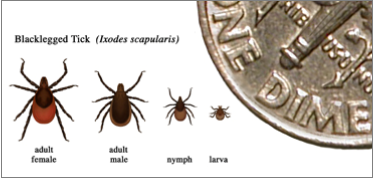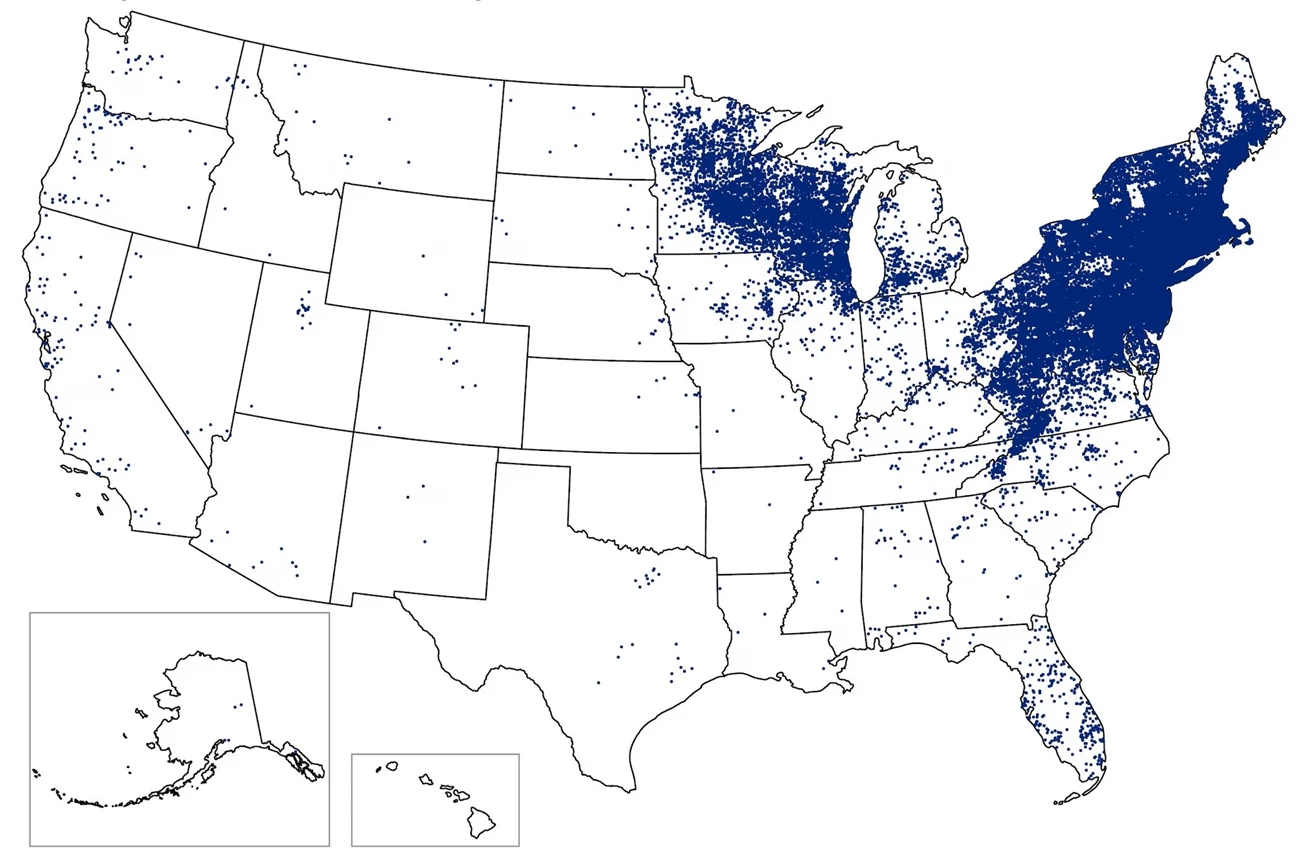Last updated: February 7, 2025
Article
One Health and Disease: Tick-Borne Disease
Tick-Borne Disease
Ticks are a natural part of many landscapes, but changes to the landscape are causing more and more ticks to spread to more areas. Some ticks can carry bacteria and viruses that can cause disease in humans and animals. Reducing exposure to ticks and removing ticks promptly can protect you and your family from tick-borne diseases.

Photo courtesy of Center for Disease Control.
General Tick-Borne Disease Information
Geographic Distribution and Seasonality
Ticks are found across the US, mostly in wooded, bushy, and grassy areas. Cases of tick-borne disease are most common during warmer months (April to September), when ticks are most active.
Hosts and Transmission
Ticks feed on a variety of animals including: deer, dogs, rodents (such as mice), birds, and reptiles. Disease is transmitted from the bite of an infected tick. Ticks, which can attach to any part of the body, are generally found on humans in hard-to-see spots such as the scalp, groin, and under the arms. Rodents are the most common reservoir or tick-borne disease. The smaller life stages of ticks are responsible for the most human tick-borne illnesses in the United States and need to be attached for many hours to transmit disease such as Lyme.
Signs and Symptoms
Human symptoms of tick-borne illness usually appear 1 to 2 weeks after the tick bite and include:
- Fever and chills
- Headache and muscle aches
- Rash
Prevention and Control
Reducing exposure to ticks is the best prevention method, especially in warmer months, when ticks are most active. To help prevent tick-borne illness:
- Hike in the center of trails- ticks can't jump so they crawl up vegetation and wait for hosts to brush against them
- Avoid wooded and bushy areas with high grass and leaf litter
- Wear insect repellant containing DEET or other EPA approved repellent- even just treating boots can dramatically reduce your risk
- Treat clothing and gear with products containing permethrin
- Carefully inspect your body, clothing, and pets for ticks after recreating
- Bathe within two hours to wash ticks off your skin before they bite
Tips for finding ticks:
- Bathe as soon as possible to easily find ticks
- Conduct a full-body check for ticks
- Use a mirror
- Parents should check their children for ticks
- Examine your gear and your pets
- Tumble clothes in dryer on high heat for an hour
How to remove a tick:
- Use fine-tipped tweezers to grasp the tick as close to the skin as you can.
- Pull upward with steady, even pressure. Don’t twist or jerk the tick.
- After removing the tick, clean the bite area and your hands with rubbing alcohol or soap and water.
- Dispose of the tick by putting it in alcohol, placing it in a sealed bag/container, wrapping it tightly in tape, or flushing it down the toilet.
Testing and Treatment
Antibiotics are effective in treating bacterial tick-borne illnesses and should be used if an infection is diagnosed.

NPS Graphic.
One Health and Tick-Borne Disease
Scientists have linked land cover changes to increased spread of tick-borne disease. Decreases in the diversity of wildlife in an area have also been linked to increases in some diseases, such as Lyme disease.
By protecting natural environments and processes, we can protect ourselves from illness – this is One Health in action.

Courtesy of the U.S. Centers for Disease Control & Prevention.
Babesiosis
Babesiosis occurs mainly in the Northeast US and can infect both humans and animals.
The disease is caused by parasites in black-legged ticks or deer ticks (Ixodes scapularis) that infect red blood cells, causing flu-like symptoms and anemia in some people and no visible signs of infection in others.
Wildlife, especially rodents such as mice and shrews, can be infected with babesiosis and infect ticks but show no signs of disease.
Colorado tick fever
Colorado tick fever is a viral tick-borne disease occurring in mountainous regions of the western US at elevations 4,000 to 10,000 feet.
The disease is not life-threatening in humans and wildlife are not known to show any signs of infection.
Ehrlichiosis
Ehrlichiosis describes several bacterial diseases that affect animals and humans.
The disease is primarily transmitted by the bite of an infected lone-star tick (Amblyomma americanum) and occurs mostly in the southeastern and south-central US.
Animals may also experience clinical symptoms such as fever, anorexia, dramatic weight loss, anemia, swelling of tissues, and/or bleeding.
Lyme disease
Lyme disease is the most common tick-borne disease in the US, occurring mostly in northeastern and north-central states.
The disease is transmitted to humans by the bite of infected black-legged tick or deer tick (Ixodes scapularis) and western black-legged tick (Ixodes pacificus).
In addition to flu-like symptoms, infected humans with the disease may also develop a red expanding circular rash, body aches, or swollen lymph nodes. Some may develop joint pain that can last for years after infection.
The white-footed mouse is the primary reservoir for the disease and shows no signs of illness when infected.
Powassan Virus
Powassan Virus is a rare but serious illness transmitted by black-legged ticks and other ticks of small rodents. The disease can progress from flu-like symptoms to encephalitis and is occasionally fatal. Cases have occurred in the Northeastern and upper Midwestern states. Cases occur primarily in the late spring, early summer, and mid-fall.
There are two different strains of Powassan virus; one is associated with the white-footed mouse and one is associated with woodchucks and their ticks.
Rocky Mountain spotted fever
Rocky Mountain spotted fever (RMSF) often causes flu-like symptoms and a characteristic rash that gives this disease its name. RMSF can be fatal in humans if not treated. Cases have been reported throughout most of the lower 48 states in the US.
RMSF is transmitted by the: American dog tick (Dermacentor variabilis), Rocky Mountain wood tick (Dermacentor andersoni), and Brown dog tick (Rhipicephalus sanguineus). Dogs are also very susceptible.
Tularemia
Tularemia is found throughout the US and is often caused by the bite of an infected tick or insect, such as a tick or deerfly.
Animals such as rabbits, beavers, muskrats, and other small rodents are particularly susceptible to the bacterium and can experience large die-offs when the population become infected. Infected humans may show flu-like symptoms and also diarrhea, joint pain, and dry cough. Tularemia symptoms in animals include fever, lethargy, incoordination, and sudden death.
Contact
Biological Resources Division and Office of Public Health1201 Oakridge Drive, Suite 200
Fort Collins, CO 80525
e-mail us
